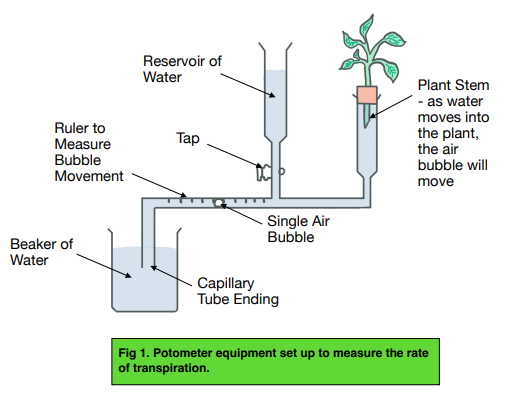Transpiration - Transpiration Rates (GCSE Biology)
Transpiration Rates
Using a Potometer to Investigate Transpiration
A potometer is a piece of equipment that can help you measure the rate of transpiration (assuming that the water taken up by the plant is related to that which evaporates from the plant). It looks like this:

- Set up the potometer in water as shown in the diagram above leaving the tap for the reservoir of water open. Make sure the equipment is set up in water to prevent any air bubbles entering the
equipment. - Make sure to cut the stem of the plant at a slant under water. This will prevent air from entering the xylem and the slant will increase the surface area over which water is absorbed.
- Lift the potometer out of the water but leave the opening end of the capillary tube submerged in the water. This is the water that will supply the plant.
- Double check that the entire equipment is airtight and watertight. You don’t want any air bubbles or extra water interfering with your experiment.
- Give time for the plant to acclimatise to this new setting and pat dry its leaves.
- Close the tap for the reservoir of water.
- Remove the capillary tube end from the water until one air bubble enters and then immediately place the capillary tube end back in the water.
- Measure and record the starting position of the air bubble and start the stopwatch.
- Time how long it takes the bubble to move a certain distance and calculate the rate of transpiration.
Calculating the Rate of Transpiration
- The rate of transpiration is an important measure. It is the amount of transpiration per unit time.

Estimate the rate of transpiration following a potometer experiment
where it took the air bubble to move a distance of 40mm in 20 minutes.
- Substitute the values into the formula.
40 / 20 = 2 mm per minute
Transpiration is the process of water movement through a plant and its evaporation from the aerial parts, mainly from the leaves but also from stems and flowers.
Transpiration serves several important functions in a plant, including:
Transporting water and nutrients from the roots to the rest of the plant.
Cooling the plant by releasing excess heat through evaporation.
Maintaining turgor pressure, or the pressure that keeps the plant rigid and upright.
Transpiration rates in plants can be influenced by several factors, including:
Humidity: High humidity can slow down transpiration rates, while low humidity can increase transpiration rates.
Light: High light intensity can increase transpiration rates, while low light intensity can decrease transpiration rates.
Temperature: High temperatures can increase transpiration rates, while low temperatures can decrease transpiration rates.
Wind: Wind can increase transpiration rates by carrying away water vapor more quickly.
Leaf surface area: A larger leaf surface area can increase transpiration rates.
Transpiration rates in plants can be measured using several methods, including:
Potometer: This is a device that measures the flow of water through a plant’s stem.
Lysimeter: This is a device that measures the mass of water lost by a plant over a certain period of time.
Porometer: This is a device that measures the rate of water vapor exchange through the stomata, or small pores on the surface of leaves.
The structure of the leaf contributes to transpiration rates by influencing the rate at which water can enter and exit the plant. The surface area of the leaf, the presence of stomata, and the thickness of the cuticle, or the waxy layer on the surface of the leaf, can all impact transpiration rates.
Environmental conditions can have a significant impact on transpiration rates in plants. For example, high temperatures, low humidity, and high light intensity can increase transpiration rates, while low temperatures, high humidity, and low light intensity can decrease transpiration rates.
Transpiration plays a critical role in plant growth and survival, as it is the means by which plants transport water and nutrients from the roots to the rest of the plant. If transpiration rates are too high or too low, this can impact the plant’s ability to absorb water and nutrients, potentially leading to stunted growth or death.






Still got a question? Leave a comment
Leave a comment